|
Introduction to Hand Engraving
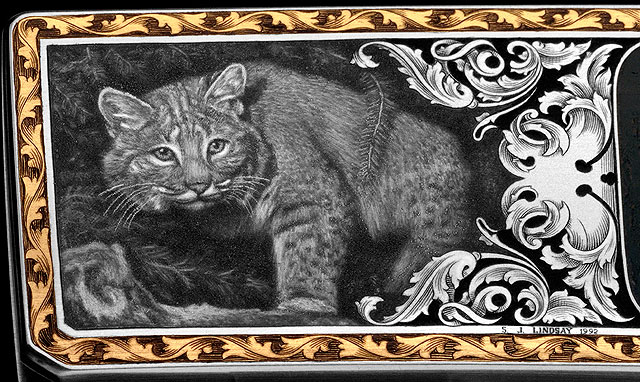
The
Art of Hand Engraving can be described as the process in which a hardened, shaped, and sharpened piece of steel, called a 'Graver', is pushed through the metal's
surface. This is done with one of three methods: by hand pressure (push graver), with a small lightweight hammer and chisel (graver), or with a pneumatic air-driven
hammer. Pneumatic AirGravers emulate both the hammer and chisel and the push-graver technique.
The graver is ground to a pointed shape adhering to very specific angles. These angles allow the graver to properly enter the metal surface and travel forward,
continuously curling the metal directly in front of the graver face, while leaving behind a small furrow.
The
shape of the graver and the angle at which it is held will ultimately
decide the furrow shape. The angle can and will often be continuously
altered during the process, allowing for the furrow to contain thick and
thin graduations of the cut line. If a square-shaped graver is used so
that one if its corners enters the metal, it will produce a "V"-shaped
furrow. Many graver shapes are available, each leading to a particular
style of engraving, and each producing a different result. Usually, the
two favored shapes are the "V" and the flat gravers. Personal preference
plays a significant role in choosing the tool used.
When using
the hammer and chisel method, both hands are required; one to hold the
graver, and the other to deliver light hammer impacts against the graver,
driving it forward through the material being cut.
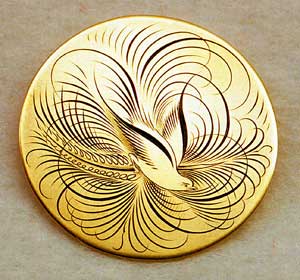
With the push graver method, the graver is generally fitted to a small wooden handle held in the
palm. The graver remains stationary, and the item being engraved is held firmly and fed into
the graver's tip, or rotated into it when a circular or curved line is desired. When making a straight line, the graver is pushed forward using only hand pressure.
Each of these methods requires a rotating vise, or a similar holding device, to hold the item being engraved.
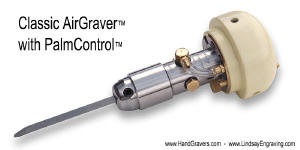 The
pneumatic
graver uses air to drive a small self-contained piston within a graver
hand piece. This piston impacts against the engraving tool in the same
fashion as in the previously described hammer and chisel method. As with
the Push Graver method, one hand is free to hold and rotate the item being
engraved. The
pneumatic
graver uses air to drive a small self-contained piston within a graver
hand piece. This piston impacts against the engraving tool in the same
fashion as in the previously described hammer and chisel method. As with
the Push Graver method, one hand is free to hold and rotate the item being
engraved.
In order to
create quality detailed engravings, the engraver is required to accurately
execute many cuts or lines in the metal that vary in length, width, and
depth. In principle, the results achieved are similar to those produced by
an artist when sketching with pen or pencil on paper. Spectacular
ornamental engravings are possible when the graver is controlled by
someone who is well versed in the art of engraving.
Use of
advanced methods, such as 'Bulino' and 'Bank note' techniques, allow the
highly skilled artist, the potential to produce exquisite, lifelike
renderings in metal.
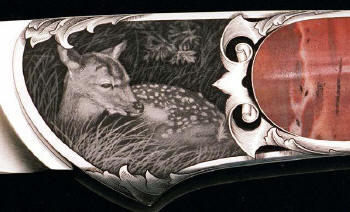 'Bulino'
(pronounced - 'bo-lee-no') - refers to a Pointillism or Dot Technique. It
is derived from the Italian term meaning "a small hand held graver". Today
the term is used loosely to represent the method of creating thousands of
small dots or lines in the metal. This enables the control of light and
dark contrasts. 'Bulino'
(pronounced - 'bo-lee-no') - refers to a Pointillism or Dot Technique. It
is derived from the Italian term meaning "a small hand held graver". Today
the term is used loosely to represent the method of creating thousands of
small dots or lines in the metal. This enables the control of light and
dark contrasts.
'Bank note
style' is a highly organized and systematic method of creating thousands
of individual lines, varying in length, in order to form beautifully
detailed renderings or ornamental designs. It is generally seen on pages
of older texts such as, family Bibles and similar period works of
literature printed from engraved plates. The closest and most common
representation of this technique in the present may be seen on paper
currency.
An artist's
ability to visualize where and how each cut should be placed determines
the final outcome of the project. When an engraving artist possesses a
talent for visualization, as well as theoretical
and technical knowledge, he or she will be able to invest the engraving
with richness, character, and even emotion.
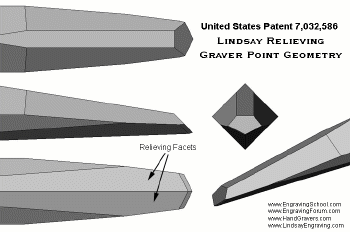 Tool
geometry and the manner in which the
graver is shaped, particularly the face and heel angles, will also
determine the quality of an engraving. The ability to perfectly
grind and shape the graver must be mastered, otherwise clean, accurate,
burr-free cutting will not occur, and the results will be unsatisfactory.
Badly raised burrs tend to produce visually jagged or distorted lines,
resulting in a rough, unrefined final product, rather than the smooth,
clean results professionals can produce.
If the engraver applies too much downward force while cutting, or the
graver
heel is too long or too short, burrs will be raised - especially when
executing curved lines. A long heel will create drag, and a short heel
will dig too deeply into the metal. Either way, the metal will be forced
upwards, generating a burr along the length of the cut. Tool
geometry and the manner in which the
graver is shaped, particularly the face and heel angles, will also
determine the quality of an engraving. The ability to perfectly
grind and shape the graver must be mastered, otherwise clean, accurate,
burr-free cutting will not occur, and the results will be unsatisfactory.
Badly raised burrs tend to produce visually jagged or distorted lines,
resulting in a rough, unrefined final product, rather than the smooth,
clean results professionals can produce.
If the engraver applies too much downward force while cutting, or the
graver
heel is too long or too short, burrs will be raised - especially when
executing curved lines. A long heel will create drag, and a short heel
will dig too deeply into the metal. Either way, the metal will be forced
upwards, generating a burr along the length of the cut.
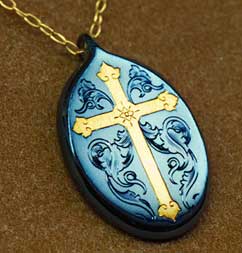 It
can take years to fully master the technical portion of hand engraving,
and to become proficient in
design and in the historical study of engraving motifs. Only then can one
begin to develop a unique and personal artistic style. However, some
students of this art may possess a natural talent, which allows them to
master the process
more rapidly. It
can take years to fully master the technical portion of hand engraving,
and to become proficient in
design and in the historical study of engraving motifs. Only then can one
begin to develop a unique and personal artistic style. However, some
students of this art may possess a natural talent, which allows them to
master the process
more rapidly.
Mastering the
Art of Engraving requires expertise in several areas. These can be divided
into two categories: art and craft. Engravers engaging only in craft need
not possess drawing and design skills to produce excellent engravings,
providing that designs are supplied beforehand by either an artist or by
replication of available ornamental patterns. Many copyright-free (public
domain) ornamental designs are available to help the craftsman in this
area. The first and foremost ability a craftsman need possess, then, is
the ability to precisely control the graver, with an understanding of the
technical skills required in order to achieve the desired results.
However, in
the case of engraver as an artist, he or she must have an intense desire
to create beautiful original designs, which depends upon a background in
other arts, together with artistic drawing talents. The art of engraving
itself can be a fulfilling medium for an artist to express his art, and
can become a life-long study.
The basic
method of hand engraving has not changed for centuries. However, with the
advent of modern
tools, today's engravers are given advantages that previous engravers did
not have at their disposal. Computer technology allows the use of photo
editing or vector-based
drawing programs, thus facilitating the design process. Using computers
and printing technologies, an artist can now successfully and accurately
lay out a design from the computer onto the item being engraved. Modern
pneumatic gravers are available in the same size as the graver of old,
allowing ease of control of the graver cut.
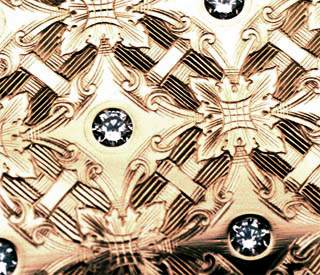 Artistic Design Concept Artistic Design Concept
Before beginning the engraving process, the engraver must visualize a
design concept, and view the item to be engraved for its shape, its period
styling, its value, materials, and contours. There are many things to
consider. If the engraving is for a customer, certain boundaries or
limitations may arise to suit the customer's price and taste.
Preparing to Draw the Design
The item being engraved must be accurately outlined. This can be achieved
using a variety of methods. The simplest method is the smoke print. This
method involves using the smoke from a kerosene lamp, candle, or
equivalent to cover the surface with carbon smoke "inking". The item is
held high over the flame so as not to heat its surface. This is important
when the item contains non-heat resistant materials. Another outlining
method is to use printer’s ink over the area. Once the surface has been
blackened by smoke or printer's ink, clear tape is delicately placed over
the area. When the tape is removed, the smoke or ink remains on the tape,
creating the exact shape of the item. An accurate outline is next traced
to be used as the design boundary lines. Another method is to use frosted
tape laid over the surface, then trace the
item's shape with a pencil. This method is less messy,
but will take a little longer. In either case, a clearly drawn outline is
the base for the beginning of the drawing process.
Creating the Final Design
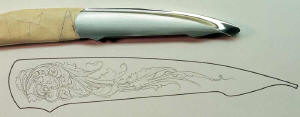
Assuming a design concept has been determined, the next step is to make
rough sketches. Sketching continues until the artist has achieved the
theme's desired flow. Refinements are slowly introduced, while maintaining
the initial feel of the art work. Imagination, creativity and familiarity
with engraving styles are important factors. The more time spent creating
a design to achieve exactly what is envisioned, the better the final
product will be. This also holds true for the quality of the drawing; the
better its quality, the better the reproduction will be when reduced to
scale for image transfer (layout of the design onto the metal).
Designs may
also be drawn directly on the item, thereby bypassing many steps. This is
possible when a familiar style of engraving is used that has been drawn
and cut many times by the artist, or if the engraving is of a less complex
design. It is usually best
to plan the design on
paper, allowing the revisions of drawings at any time prior to the actual
engraving process. There are many methods for transferring the design or
layout onto the surface that is to be engraved. One is to scratch the
design on to plastic mylar which is used to make an ink or smoke print
transfer. Another method is drawing with soft lead pencil on mylar, and
pulling the lead up with tape, eventually transferring the lead from the
tape. A third method is photographic transfer, and a fourth is done with a
laser or inkjet computer printer.
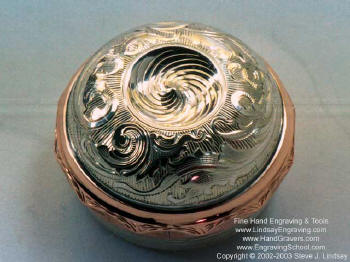 The Technical Aspects of Engraving The Technical Aspects of Engraving
When the design has been transferred onto the metal, the engraving process
may begin. The most commonly used graver point is the square "V" cut
graver, which works well for a variety of engraving styles.
Several
details
must be considered prior to the actual cutting of the pattern. If the
engraving is to be relieved, backgrounds will need to be removed, leaving
the decorative pattern as a raised or relieved engraving. A precious metal
inlay may be part of the design. Gold, platinum, or silver - wire or sheet
would be cut and hammered carefully into the desired areas. Both relief
and inlay engraving share a common initial step: a design is cut by
following or tracing the transferred design’s outlines with the graver. In
the case of gold inlay, it must be determined which area of the design
will have gold. In those portions of the design, the material will be cut
out accurately by graver or dental air drill to a predetermined depth,
based on the thickness of the precious metal to be inlaid. This cutout is
called a “pocket”. When the pocket has been cut and leveled to proper
depth, a small channel is cut along the base of the inner wall, creating
an undercut. This could be called a "dovetail", a term familiar to
woodworkers. In this case, the undercut is needed to hold the gold
securely in place. The gold, having been cut to fit this pocket, will now
be placed in the pocket. Its
surface will be carefully hammered, usually with a brass punch. The
hammering may be accomplished using a pneumatic AirGraver and brass punch,
or with a traditional hammer
and punch method. In either case, the result is the same. During impact,
the gold undergoes expansion, spreading into the undercuts of the pocket,
which secures it firmly in place.
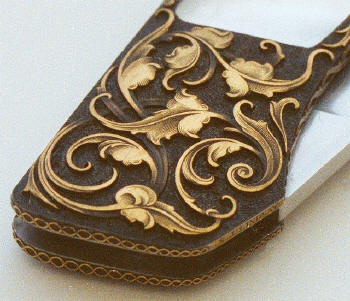 If
the inlay is to remain raised above the metal surface, steps are taken in order to calculate the position and shape of the pocket. This is done prior to the inlay
by making a smoke or ink print of the pocket for later use. This is a vital step, and cannot be overlooked, since the procedure of inlaying precious metal involves
hammering. Hammering, in turn, causes the gold's surface to become mushroomed and cover the pocket’s outline area. It is difficult to accurately trim excess gold.
If too much is trimmed, the gold may lack in the image area, and if not enough is trimmed, the inlay will not fit the pocket shape. This can result in
the appearance of a fatter image or inaccuracies where detail is needed. Because an ink or smoke print was taken of the pocket prior to inlaying, this print can be
laid over the mushroomed gold to determine exactly where the pocket is located. If
the inlay is to remain raised above the metal surface, steps are taken in order to calculate the position and shape of the pocket. This is done prior to the inlay
by making a smoke or ink print of the pocket for later use. This is a vital step, and cannot be overlooked, since the procedure of inlaying precious metal involves
hammering. Hammering, in turn, causes the gold's surface to become mushroomed and cover the pocket’s outline area. It is difficult to accurately trim excess gold.
If too much is trimmed, the gold may lack in the image area, and if not enough is trimmed, the inlay will not fit the pocket shape. This can result in
the appearance of a fatter image or inaccuracies where detail is needed. Because an ink or smoke print was taken of the pocket prior to inlaying, this print can be
laid over the mushroomed gold to determine exactly where the pocket is located.
The next stage involves leveling of the inlay surface. This can be achieved by filing, sanding and
polishing to the predetermined height of the image being inlaid. Once the inlay surface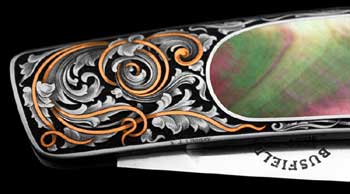 is leveled and scratch-free, the gold
can be detailed. Detailing may include line engraving, bulino, banknote techniques, or sculpting. The process is somewhat easier if the gold inlay is to be flush
and level with the base metal surface, since there are no difficulties with mushroomed gold and pocket position. The surface is simply
filed, sanded, and polished flush.
is leveled and scratch-free, the gold
can be detailed. Detailing may include line engraving, bulino, banknote techniques, or sculpting. The process is somewhat easier if the gold inlay is to be flush
and level with the base metal surface, since there are no difficulties with mushroomed gold and pocket position. The surface is simply
filed, sanded, and polished flush.
Relief engraving is simpler by comparison to inlay work, and only requires the removal
of background around the design. This is accomplished by cutting away the metal background and
leaving the decorative motif design in the foreground. The cutout background may be
decoratively punched to create a matted textured, or it may be lined to create interesting light reflection effects. There are several methods in which the
background may be detailed. Some of them are punching, stippling, lining, and beading.
Having accomplished the above, detailing of the decorative motif will begin. This step is labeled as
shading. Shading is the process by which multiple, tightly grouped fine lines or dots are
applied in order to achieve light-to-dark contrasts. This defining step can raise or lower the overall quality of the engraving. Correctly produced, it will add
life to the art. If shading is not fully understood and expertly executed, however, the engraver runs the risk of lowering the quality of his previous efforts.
Shading is the highlight of quality engraving, and is perhaps the most difficult area for the beginning and intermediate level engraver to develop proficiency.
Collectors who recognize quality engraving examine the shading and look for precision, continuity, and character in the shaded areas.
|